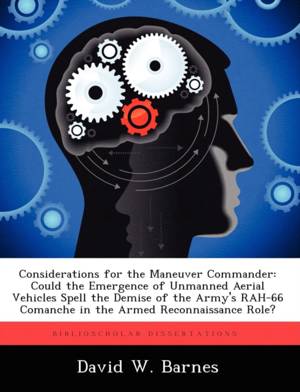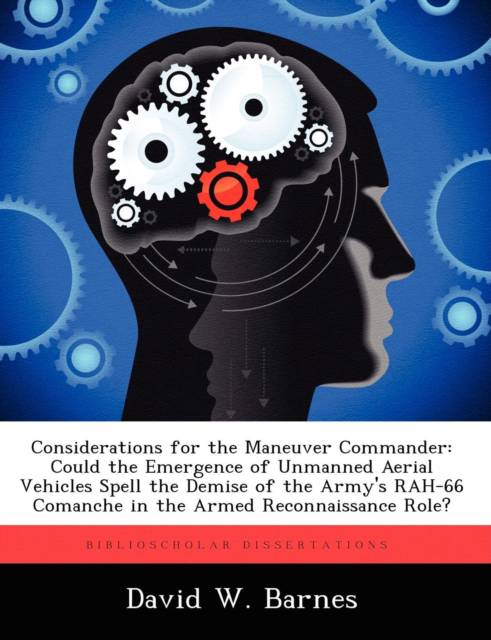
Door een staking bij bpost kan je online bestelling op dit moment iets langer onderweg zijn dan voorzien. Dringend iets nodig? Onze winkels ontvangen jou met open armen!
- Afhalen na 1 uur in een winkel met voorraad
- Gratis thuislevering in België vanaf € 30
- Ruim aanbod met 7 miljoen producten
Door een staking bij bpost kan je online bestelling op dit moment iets langer onderweg zijn dan voorzien. Dringend iets nodig? Onze winkels ontvangen jou met open armen!
- Afhalen na 1 uur in een winkel met voorraad
- Gratis thuislevering in België vanaf € 30
- Ruim aanbod met 7 miljoen producten
Zoeken
Considerations for the Maneuver Commander
Could the Emergence of Unmanned Aerial Vehicles Spell the Demise of the Army's Rah-66 Comanche in the Armed
David W Barnes
Paperback | Engels
€ 54,45
+ 108 punten
Omschrijving
The U.S. Army finds itself at a crossroad in the development and fielding of both unmanned aerial vehicles (UAVs) and the RAH-66 Comanche helicopter to fulfill the armed reconnaissance role for its future Objective Force (OF). Ever-increasing UAV capabilities, especially the ability to arm these platforms with Hellfire missiles, is forcing a blending of roles that were once solely the domain of manned platforms. This paper attempts to answer the thesis question posed above by using the OF characteristics of survivability, lethality, and responsiveness and comparing the effectiveness and efficiency of the Army's Class IV UAV systems (Hunter TUAV, Shadow 200, the Extended Range Multi-Purpose (ERMP), the Hummingbird 160 UCAR, and the Air Force's Predator A and B) against similar capabilities found in the Comanche. The analysis also highlights what the maneuver commander should consider in employing these future combat systems. The author concludes, based on the above criteria, that future UAV capabilities (up to the 2009 year timeframe) should not preclude the need for the Army to field the Comanche.
Specificaties
Betrokkenen
- Auteur(s):
- Uitgeverij:
Inhoud
- Aantal bladzijden:
- 106
- Taal:
- Engels
Eigenschappen
- Productcode (EAN):
- 9781249365129
- Verschijningsdatum:
- 13/09/2012
- Uitvoering:
- Paperback
- Formaat:
- Trade paperback (VS)
- Afmetingen:
- 189 mm x 246 mm
- Gewicht:
- 204 g

Alleen bij Standaard Boekhandel
+ 108 punten op je klantenkaart van Standaard Boekhandel
Beoordelingen
We publiceren alleen reviews die voldoen aan de voorwaarden voor reviews. Bekijk onze voorwaarden voor reviews.











